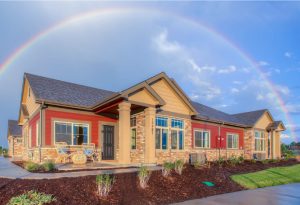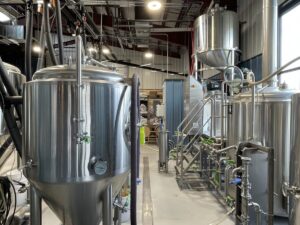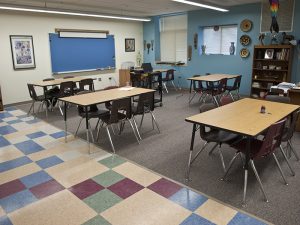As the population ages, the demand for senior housing that supports health and well-being is growing. Thus, architects are increasingly incorporating science-based senior housing design features into senior living communities to enhance the quality of life for aging adults. These design innovations focus on creating environments that promote physical health, cognitive function, and social engagement.
Biophilic Design
Biophilic design integrates natural elements into living spaces, benefiting mental and physical health. In senior housing, features like natural light, indoor plants, and views of nature reduce stress and enhance mood. Research from Terrapin Bright Green (2014) shows that exposure to these elements lowers blood pressure and improves cognitive function in older adults.
Universal Design
Universal design principles ensure that environments are accessible and usable by people of all ages and abilities. Features such as no-step entries, wide doorways, and lever handles make homes safer and more comfortable for seniors. According to the Journal of Aging Research, these design elements can significantly reduce the risk of falls and enhance independence (Steinfeld & Maisel, 2012).
Cognitive Supportive Environments
Designing for cognitive support means creating environments that assist seniors with memory and orientation. These include clear signage, distinct color schemes, and easily navigable layouts, which can benefit those with cognitive impairments. According to research in the Herd: Health Environments Research & Design Journal (Marquardt, Bueter, & Motzek, 2014), these features improve wayfinding and reduce anxiety among residents with dementia
Social Spaces
Creating social spaces is crucial for promoting interaction and preventing isolation among seniors. Common areas such as community rooms, gardens, and cafes encourage socialization and community building. A report by the National Institute on Aging states that social engagement is linked to better mental health and lower rates of chronic diseases in older adults (NIA, 2020).
Multi-Sensory Environments
Multi-sensory environments can enhance the well-being of seniors by engaging their senses in a meaningful way. Features like sensory gardens, tactile art installations, and aromatherapy can stimulate senses and improve mood and cognitive function. According to a study in the Journal of NeuroEngineering and Rehabilitation, multi-sensory stimulation can have therapeutic benefits for individuals with dementia (Baker et al., 2015).
Sustainable and Healthy Materials
Using sustainable and non-toxic materials in senior housing can improve indoor air quality and reduce health risks. Low-VOC paints, natural wood finishes, and hypoallergenic carpeting are essential for creating a healthy living environment. The U.S. Green Building Council notes that green buildings can enhance indoor air quality, which is crucial for the respiratory health of seniors (USGBC, 2020).
Conclusion
In summary, incorporating these science-based design features in senior housing can enhance the quality of life for aging adults. Accordingly, as architects, it is essential to stay informed about these emerging trends. Additionally, we should apply them to create environments that promote health, independence, and well-being. By embracing these innovations, we can design senior living communities that support and enrich the lives of older adults. Reach out to our senior housing experts at EVstudio to discuss how these or other features can be incorporated into your next senior housing project.











